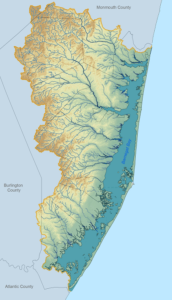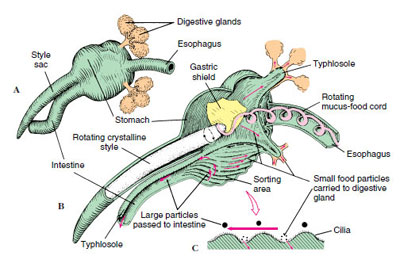
Barnegat Bay Environment
The Watershed
Introduction
A watershed is an area of land that drains all the streams and rainfall to a common outlet such as the outflow of a reservoir, mouth of a bay, or any point along a stream channel.
Watersheds can be as small as a footprint or large enough to encompass all the land that drains water into Barnegat Bay,
The watershed consists of surface water–lakes, streams, reservoirs, and wetlands–and all the underlying groundwater.
Larger watersheds contain many smaller watersheds.
It all depends on the outflow point. all of the land that drains water to the outflow point is the watershed for that outflow location.
Watersheds are important because the streamflow and the water quality of a river are affected by things, human-induced or not, happening in the land area “above” the river-outflow point.
The word “watershed” is sometimes used interchangeably with drainage basin or catchment. Ridges and hills that separate two watersheds are called the drainage divide
 The Barnegat Bay watershed is the area of land making up the Bay’s drainage system covers over 600 square miles.
The Barnegat Bay watershed is the area of land making up the Bay’s drainage system covers over 600 square miles.
The watershed’s characteristics vary from coastal dunes and marshes to other developed lands, to protected Pine Barrens habitats within the Pinelands
Over 560,000 people reside within the Barnegat Bay watershed, which includes nearly all of Ocean County and portions of Monmouth County.
The watershed is the land area from which water flows into creek and rivers and eventually into the bay.
Water reaches the bay in several different ways:
- Tidal flow from the Atlantic. Saltwater flows in and ebbs out though the three inlets.
- Storm surge, high winds and storms can push ocean water over the barrier islands
- Streams empty into rivers and creeks that empty fresh water into the bay.
- Surface water runoff goes directly or indirectly into the bay.
- Groundwater may eventually seep into the bay.
- Rain does go directly into the bay but mostly as surface runoff.
Not all precipitation that falls in a watershed flows out.
There are many factors that determine how much water flows in a stream (these factors are universal in nature and not particular to a single stream):
Precipitation:
The greatest factor controlling streamflow is the amount of precipitation that falls in the watershed as rain or snow. However, not all precipitation that falls in a watershed flows out, and a stream will often continue to flow where there is no direct runoff from recent precipitation.
Infiltration:
When rain falls on dry ground, some of the water soaks in, or infiltrates the soil.
Some water that infiltrates will remain in the shallow soil layer, where it will gradually move downhill, through the soil, and eventually enters the stream by seepage into the stream bank
Some of the water may infiltrate much deeper, recharging groundwater aquifers.
Water may travel long distances or remain in storage for long periods before returning to the surface.
The amount of water that will soak in over time depends on several characteristics of the watershed:
Soil characteristics:
Clay and rocky soils absorb less water at a slower rate than sandy soils.
Soils absorbing less water results in more runoff overland into streams.
Soil saturation:
Like a wet sponge, soil already saturated from previous rainfall cannot absorb much more … more rainfall will become surface runoff.
Land cover:
Some land covers have a great impact on infiltration and rainfall runoff. Impervious surfaces, such as parking lots, roads, and developments, act as a “fast lane” for rainfall – right into storm drains that drain directly into streams.
Flooding becomes more prevalent as the area of impervious surfaces increase.
Slope of the land:
Water falling on steeply-sloped land runs off more quickly than water falling on flat land.
Evaporation:
Water from rainfall returns to the atmosphere largely through evaporation. The amount of evaporation depends on temperature, solar radiation, wind, atmospheric pressure, and other factors.
Transpiration/Evapotranspiration:
The root systems of plants absorb water from the surrounding soil in various amounts.
Most of this water moves through the plant and escapes into the atmosphere through the leaves.
Transpiration is controlled by the same factors as evaporation, and by the characteristics and density of the vegetation.
Vegetation slows runoff and allows water to seep into the ground.
Storage:
Reservoirs store water and increase the amount of water that evaporates and infiltrates. The storage and release of water in reservoirs can have a significant effect on streamflow patterns of a river below a dam.
Water use by people:
Uses of a streams and aquafers might range from a few homeowners and businesses pumping small amounts of water to irrigate their lawns to large amounts of water withdrawals for irrigation, industries, mining, and to supply populations with drinking water.
Fun Fact – The Barnegat Bay watershed is comprised of 11 subwatersheds and the barrier island communities.

